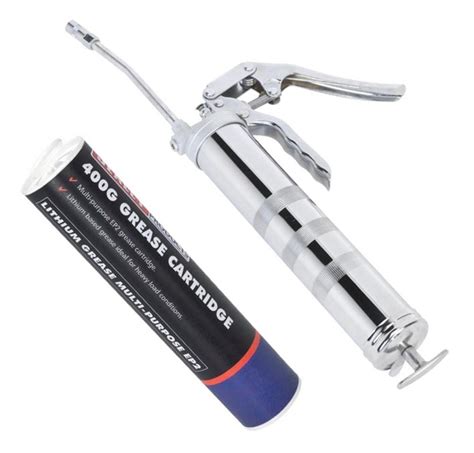The Ultimate Guide to Grease Guns: Maintaining and Lubricating Equipment Effectively
Introduction
Grease guns are indispensable tools for maintenance and lubrication in various industries and DIY projects. By delivering grease into fittings, they contribute to the smooth operation and longevity of machinery, vehicles, and equipment. This comprehensive guide covers everything you need to know about grease guns, including types, features, applications, and best practices for their use.
Types of Grease Guns
Manual Grease Guns
-
Lever-action grease guns: Operated manually by pumping a lever, they offer high pressure and can handle thicker greases.
-
Pistol-grip grease guns: Ergonomic and portable, they are suitable for home use and light maintenance.
Power Grease Guns
-
Electric grease guns: Powered by an electric motor, they provide consistent pressure and are ideal for heavy-duty applications.
-
Pneumatic grease guns: Utilize compressed air to drive the piston, offering high pressure and fast flow rates.
-
Battery-operated grease guns: Offer portability and convenience for on-site lubrication.
Features to Consider When Choosing a Grease Gun
-
Pressure: Determines the force at which grease is applied, typically measured in PSI (pounds per square inch).
-
Flow Rate: Indicates how much grease is delivered per stroke or minute, affecting lubrication efficiency.
-
Volume Capacity: Refers to the amount of grease the gun can hold, reducing interruptions during use.
-
Compatibility: Ensure the gun is compatible with the specific grease and fittings you need to lubricate.
-
Accessories: Some grease guns come with attachments like extension hoses, nozzles, and couplers for versatility.
Applications of Grease Guns
-
Machinery Maintenance: Lubricating bearings, gears, and other moving parts of industrial equipment.
-
Automotive Repair: Greasing chassis components, suspension parts, and steering systems of vehicles.
-
Marine Maintenance: Protecting marine engines, propellers, and gearboxes from corrosion and wear.
-
Home DIY Projects: Lubricating lawnmowers, bicycles, garage door openers, and other appliances.
-
Construction: Greasing heavy equipment, cranes, and excavation machinery.
Best Practices for Using Grease Guns
-
Choose the Right Grease: Select a grease suitable for the specific application and operating conditions.
-
Prepare the Gun: Fill the gun with grease according to manufacturer's instructions and remove air pockets by pumping out a small amount.
-
Connect to the Fitting: Securely connect the gun's nozzle to the grease fitting, ensuring a snug connection.
-
Apply Grease: Pump the lever or trigger to deliver the required amount of grease, avoiding over-lubrication.
-
Disconnect and Clean: Once lubrication is complete, disconnect the gun and wipe any excess grease from the fitting and nozzle.
Safety Precautions
When using grease guns, it's crucial to prioritize safety:
- Wear safety glasses to protect your eyes from grease splashes.
- Use caution when handling high-pressure guns to prevent injury.
- Avoid skin contact with grease to minimize irritation.
- Dispose of used grease and cartridges responsibly to prevent environmental contamination.
Cost of Grease Guns
The cost of grease guns varies depending on their type, features, and brand:
| Type |
Average Cost |
| Manual lever-action |
$20-$80 |
| Manual pistol-grip |
$10-$50 |
| Electric |
$100-$300 |
| Pneumatic |
$150-$500 |
| Battery-operated |
$150-$350 |
Stories and Lessons Learned
Story 1:


A manufacturing plant experienced premature bearing failure due to inadequate lubrication. After implementing a proper grease gun maintenance program, bearing life was significantly extended, reducing downtime and maintenance costs.
Lesson: Regular lubrication is crucial for preventing costly equipment failures.
Story 2:

A construction crew faced delays due to a faulty grease gun. By investing in a high-quality, high-pressure grease gun, they improved their efficiency and completed projects on time.

Lesson: Using the right tools for the job can save time and money.
Story 3:
A home mechanic who neglected to wear safety glasses while using a grease gun suffered an eye injury. This incident emphasized the importance of safety precautions when handling pressurized tools.
Lesson: Prioritizing safety should never be compromised.
Tips and Tricks
- For hard-to-reach fittings, use an extension hose and/or flexible nozzle.
- Purge air pockets from the grease gun by operating it vertically and bleeding out any excess air.
- Clean grease fittings before connecting the gun to prevent contamination.
- Store grease guns away from extreme temperatures and moisture to prolong their lifespan.
How to Use a Grease Gun: Step-by-Step
-
Prepare the Gun: Fill the gun with grease and bleed out any air pockets.
-
Connect to the Fitting: Securely attach the nozzle to the grease fitting.
-
Grip the Gun: Hold the gun firmly using both hands.
-
Pump the Lever or Trigger: Apply even pressure to deliver grease into the fitting.
-
Monitor Grease Flow: Continue pumping until you see grease emerging from the fitting.
-
Disconnect the Gun: Once lubrication is complete, remove the nozzle from the fitting.
-
Clean Up: Wipe away any excess grease from the fitting and nozzle.
Conclusion
Grease guns are essential tools for maintaining equipment and ensuring its smooth operation. By understanding the different types, features, and best practices for using grease guns, you can effectively lubricate machinery, vehicles, and equipment, extending their lifespan and minimizing downtime. Always prioritize safety, select the right grease gun for the job, and follow recommended maintenance protocols to achieve optimal lubrication results.
